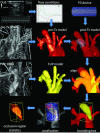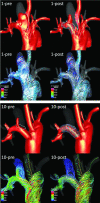Analysis of hemodynamics and aneurysm occlusion after flow-diverting treatment in rabbit models
- PMID: 24722302
- PMCID: PMC4212815
- DOI: 10.3174/ajnr.A3913
Analysis of hemodynamics and aneurysm occlusion after flow-diverting treatment in rabbit models
Abstract
Background and purpose: Predicting the outcome of flow diversion treatment of cerebral aneurysms remains challenging. Our aim was to investigate the relationship between hemodynamic conditions created immediately after flow diversion and subsequent occlusion of experimental aneurysms in rabbits.
Materials and methods: The hemodynamic environment before and after flow-diversion treatment of elastase-induced aneurysms in 20 rabbits was modeled by using image-based computational fluid dynamics. Local aneurysm occlusion was quantified by using a voxelization technique on 3D images acquired 8 weeks after treatment. Global and local voxel-by-voxel hemodynamic variables were used to statistically compare aneurysm regions that later thrombosed to regions that remained patent.
Results: Six aneurysms remained patent at 8 weeks, while 14 were completely or nearly completely occluded. Patent aneurysms had statistically larger neck sizes (P = .0015) and smaller mean transit times (P = .02). The velocity, vorticity, and shear rate were approximately 2.8 times (P < .0001) larger in patent regions-that is, they had larger "flow activity" than regions that progressed to occlusion. Statistical models based on local hemodynamic variables were capable of predicting local occlusion with good precision (84% accuracy), especially away from the neck (92%-94%). Predictions near the neck were poorer (73% accuracy).
Conclusions: These results suggests that the dominant healing mechanism of occlusion within the aneurysm dome is related to slow-flow-induced thrombosis, while near the neck, other processes could be at play simultaneously.
© 2014 by American Journal of Neuroradiology.
Figures



References
-
- Lylyk P, Miranda C, Ceratto R, et al. Curative endovascular reconstruction of cerebral aneurysms with the Pipeline embolization device: the Buenos Aires experience. Neurosurgery 2009;64:632–642 - PubMed
-
- Seong J, Wakhloo AK, Lieber BB. In vitro evaluation of flow divertors in an elastase-induced saccular aneurysm model in rabbit. J Biomech Eng 2007;129:863–72 - PubMed
-
- Kallmes D, Ding YH, Dai D, et al. . A new endoluminal, flow disrupting device for treatment of saccular aneurysms. Stroke 2007;38:2346–52 - PubMed
Publication types
MeSH terms
Grants and funding
LinkOut - more resources
Full Text Sources
Other Literature Sources
Medical
